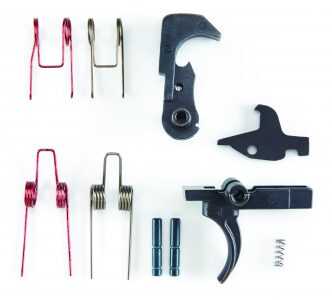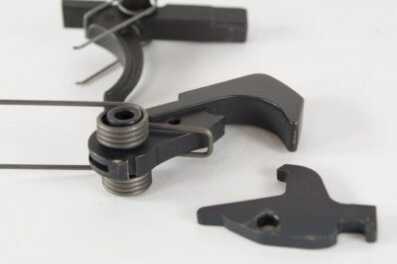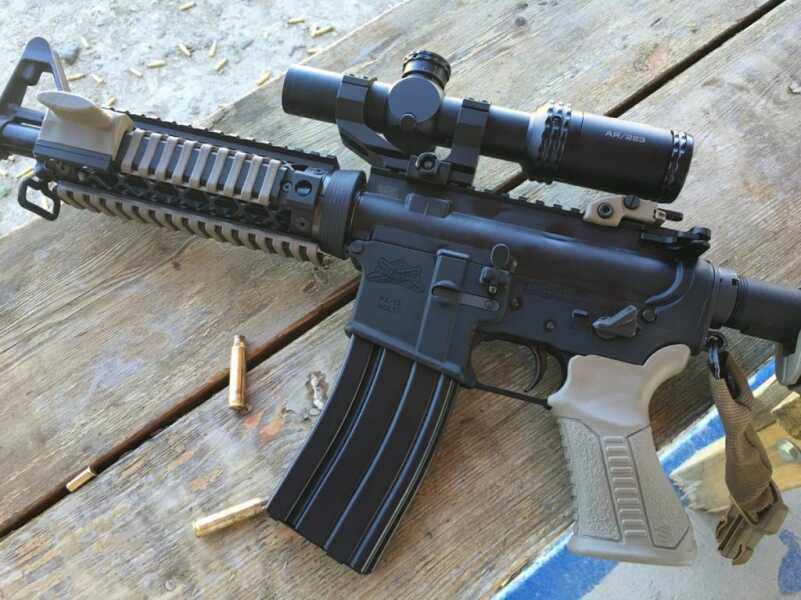
Blackhawk’s Blaze Trigger uses Boron-infused steel to maintain exact mil-spec dimensions while improving trigger function and longevity.
To learn more, visit https://staging.blackhawk.com/Products/Long-Gun-Accessories/Long-Gun-Accessories/On-Gun-Components/Control-Upgrades/AR-Blaze-Single-Stage-Duty-Trigger-(SSD).aspx.
I love AR-15 type rifles as much, and probably more than the next guy. But if we’re all to be honest with each other, I think we can agree that the standard mil-spec trigger kind of sucks. Of all the (standard, not premium) rifles I’ve handled over the years, there are very few that have a trigger worthy of positive thoughts. I guess it’s just part of the design. After all, the AR-15 / M-16 wasn’t really designed for all the things we’re using it for now like long range, precision shooting and use with infinity plus seven different calibers.
As a result, for rifles I buy, the very first thing I do is remove the existing mil-spec trigger, curse at it, then bury it in the swamp behind my house. Then I install a decent trigger like an AR Gold, Timney or Geissele. Once you shoot a “good” trigger, you’ll be spoiled forever. Obviously, a trigger upgrade doesn’t make the gun mechanically more accurate, but it does make it a heck of a lot easier to shoot the rifle more accurately. That’s part of the design goal behind Blackhawk’s AR Blaze Trigger for AR-15 rifles.
So why do mil-spec triggers suck the fun out of shooting? It’s not the pull weight really. A six or seven-pound trigger of a rifle isn’t necessarily a bad thing, provided that it’s smooth, consistent, and crisp. Most mil-spec triggers feel like the sear surfaces have been coated with 200-year old brick, so when you start your trigger pull, the primary sensation you feel is something like fingernails on a chalkboard. When things aren’t smooth, they’re no longer predictable either.
I pulled two ARs out of the safe, both “standard” models made by reputable companies and did a bunch of dry fire trigger pulls – some using a trigger scale and others just listening and feeling operation. The first rifle almost always had a take-up stage that ended in an abrupt “click” before pressure increased before the break. While it was OK, I wouldn’t describe the break as crisp. Weight varied with each pull between 6.75 and 7.5 pounds. On the second rifle, the take-up stage was much improved with hardly any before the pre-break pressure. The gritty feel was much less than most standard triggers, but the weight was all over the map with pull measuring between 5.5 and 7.5 pounds on any given shot. Meh.

The $99.95 kit includes trigger components and two sets of trigger and hammer springs for six and 4.7-pound pull weights.
The “meh” factor of AR triggers is exactly why Blackhawk! put some nifty patent-pending Boron infusion technology to good use with an improved mil-spec trigger system. Sure, you can spend a few hundred on a souped-up completion trigger with a three-pound pull, but that’s not ideal for a defensive rifle and certainly not appropriate for applications like law enforcement or military use. One of the driving forces behind the Blaze trigger system was to create a true mil-spec trigger that was compliant in all ways, but better. There were two design elements that the Blackhawk! folks had to consider: mil-spec dimensions and trigger weight.
If you’re going to improve the quality and feel of trigger components, one approach is to start tinkering with the materials by adding super-slick coatings. However, when you start applying surface coatings to parts, the dimensions are going to increase. Whether the amount of dimension change is significant or not is a discussion for another day. The Blaze system relies on no such “coating.” Rather, the Boron treatment is infused (for lack of a better word) into the metal, so there is no surface dimensional change. Nor does the treatment wear off, again because it’s not a coating – it becomes part of the steel. The end result is that the trigger components adopt the good properties of a super-slick treatment process, but without any size or shape change. The parts remain exactly mil-spec in all dimensions.

The Boron treatment is not a coating. It actually makes the steel extremely hard and slick, so no lubricants are required.
The second consideration for the law enforcement market is trigger pull weight. From a liability and practical safety standpoint, departments aren’t keen on patrol guns being equipped with ultra-light competition triggers. It’s far better to have a standard weight trigger that requires six or so pounds of force to break. However, that doesn’t mean that the quality of the trigger can’t be dramatically improved. A trigger with a smooth and crisp break makes a rifle much easier to shoot accurately.

Interestingly, to satisfy certain finicky mil-spec customers, Blackhawk has to apply a color treatment over the boron-infused metal. That’s the darker areas.
While I mention these two design approaches in a law enforcement context, they have relevance in the commercial world too. Keeping replacement parts in exact size spec reduces the chance of function problems. As for trigger pull weight, using a gun that has standard trigger weight only helps with potential liability challenges. If you ever have to defend your actions in a courtroom, it’s certainly not going to hurt your case to be able to say “my gun was equipped with a standard weight trigger, just like those that the local police use.” Additionally, it’s not a bad thing to use a trigger that requires a deliberate press in a self-defense application to minimize the risk of a negligent discharge while under stress.
There are more practical and tangible benefits to the Boron infusion process. The resulting steel parts are really, really hard and really, really smooth. That means they require no lubrication – at all. No lubricant means no maintenance. It also means there’s no liquid or grease to attract dirt, carbon residue, and grit over time. The hard and slick surface means it’s easier to clean. Put all this together and the useful life goes well into the tens of thousands of trigger pulls.
I installed a Blaze trigger in a Palmetto State Armory 16: Freedom Rifle to run it through its paces. Right off the bat, I used it for a couple of days of moderate volume use during class and plinking sessions in the dry and dusty environment near Bozeman, Montana. Per the specs, I didn’t use any lube and ran somewhere near 300 rounds through the rifle. After shipping it back home, I’ve been using it in the humid environment of South Carolina, still without cleaning or lubrication.
What I have noticed most is consistency. This trigger operates exactly the same, every single time it’s pulled. When measuring pull with my Timney Triggers scale, I get exactly 6.5 pounds every time. If you want a lighter pull, you can swap out the mil-spec trigger and hammer springs for a “target” set that’s also included with the package. These are coated red for easy identification, and reduce the pull weight to about 4.7 pounds.
If you’re a hard-core competition shooter, you’ll most likely want to save your pennies for a competition trigger replacement. However, if your needs revolve around defensive use, staying mil-spec is a good idea. The Blaze kit can dramatically improve quality, while still keeping dimensions and pull weight right for reliability and safety.
MSRP is $99.95
To learn more, visit https://staging.blackhawk.com/Products/Long-Gun-Accessories/Long-Gun-Accessories/On-Gun-Components/Control-Upgrades/AR-Blaze-Single-Stage-Duty-Trigger-(SSD).aspx.


Savage MRS 10 Hunter w/BLACKHAWK! trigger with Nickel Boron treatment…Despite having the worst trigger pull I’ve ever experienced in any AR type weapon I couldn’t be happier with the groups it produced. Can’t wait to try it with a decent trigger, should be amazing.
Tossed my Trijicon ACOG 4×32 on the rail and the 1st 3 shots out of the new gun at 50 yrds all centered in the bullseye touching each other. Scope adjustment…not needed…2 more 3 shot groups equaled the 1st…outstanding! Too bad the trigger makes it almost unbearable to shoot.
Something is missing in this review–how does this trigger feel? The author described to mil-spec triggers he has in existing rifles, but other than pull weight, utterly ignores the issue of take-up, feel and reset in this trigger. Try again please.